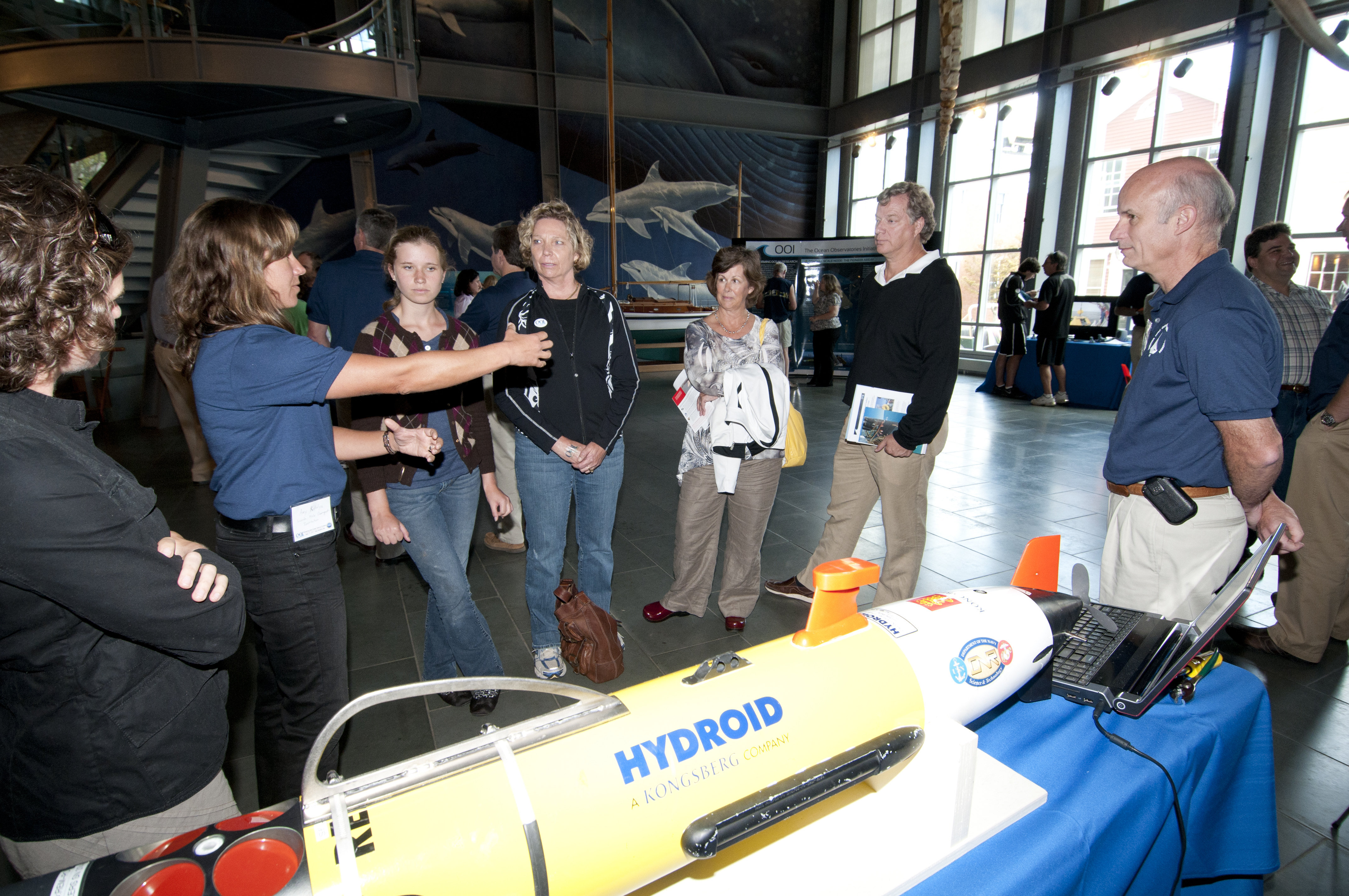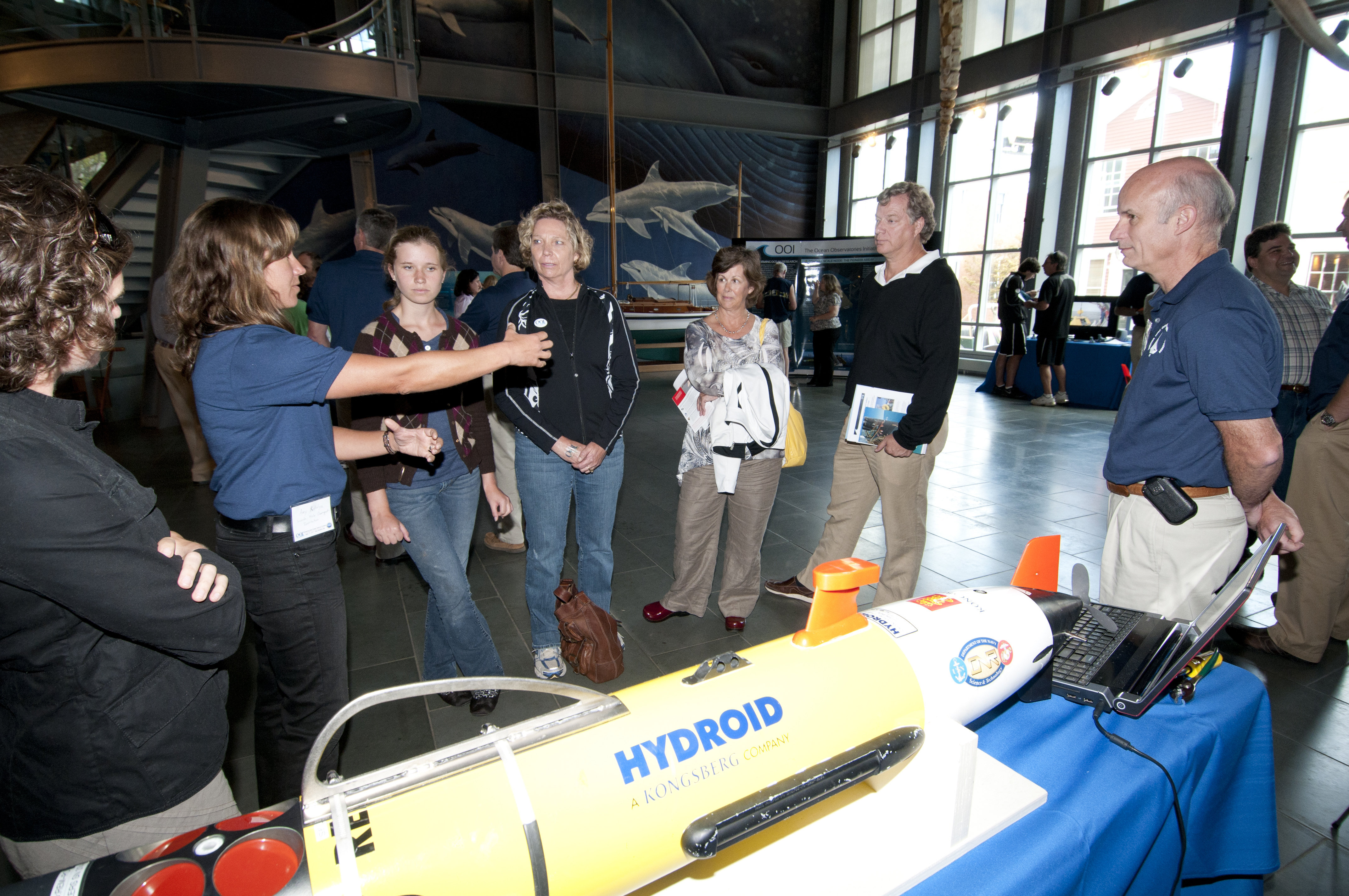Ocean Observatories Initiative Displayed at East Coast Community Event

(Click to enlarge) Amy Kukulya (second from left) and Al Pluddemann (right), both of Woods Hole Oceanographic Institution, discuss REMUS Autonomous Underwater Vehicle operations with visitors at an OOI community event at The New Bedford Whaling Museum. (Credit: Jayne Doucette, Woods Hole Oceanographic Institution)
The Ocean Observatories Initiative (OOI) program sponsored a community event on Sept. 17 at the New Bedford Whaling Museum located in New Bedford, Mass., where the public viewed equipment displays, watched interactive videos and met with scientists from the program.
OOI scientists and experts from the OOI Program Office at the Consortium for Ocean Leadership and the Woods Hole Oceanographic Institution (WHOI) conducted hands-on demonstrations and gave talks so that all ages of visitors from the coastal community could learn about the OOI. Scientists from the University of Massachusetts Dartmouth also provided demonstrations on how ongoing ocean research and education will benefit from data that will result from the OOI.
Visitors to the event were particularly interested in learning about the Pioneer Array component of the OOI that will operate off their local coast. Pioneer Array will be located off the coast of southern New England along the “continental shelf-break,” the boundary where coastal waters meet the open ocean. Information gleaned from the Pioneer Array will include sea temperature, winds, wave height and currents. The Array will be comprised of 10 moorings distributed among seven sites, three Autonomous Underwater Vehicles (UAVs) and six gliders.
“The Pioneer Array will give us the unique ability to obtain continuous measurements, over a range of spatial scales, from moorings, gliders, and AUVs, each observing a variety of ocean processes over the shelf and across the shelf break,” Tim Cowles, Vice President & Director of Ocean Observing at the Consortium for Ocean Leadership, told visitors. “This approach to obtaining continuous ocean measurements will lead to new insights and better answers to our science questions, while also revealing new questions to be addressed. It is tremendously exciting to know that we will be observing the ocean in ways that weren’t possible with traditional research methods.”
President and Director of Woods Hole Oceanographic Institution Susan Avery told the crowd while the regional focus of the OOI is on the continental shelf, the data gathered from the OOI has larger global implications. The OOI data, Avery explained, will foster a better understanding of the ocean for all and help address questions such as what caused the catastrophic seafloor earthquakes that brought such desolation this year to Japan, and last year to Haiti and Chile. Giving an example on the local level, she added the OOI data could prove beneficial in predicting whether the next hurricane will again test the New Bedford seawall, or whether it will veer out to sea.
“The Ocean Observatories Initiative will revolutionize the way we study, think about, and come to know the ocean,” Avery said. “It will help us to reveal the 70 percent of our planet that remains such a mystery in so many ways.”
Steve Lohrenz, Dean of the School for Marine Science and Technology (SMAST) at the University of Massachusetts Dartmouth, told the audience he is excited about the opportunities that the Pioneer Array will provide for research and collaboration.
“Scientists at SMAST are actively involved in research in this region and some of that work is displayed here today,” Lohrenz said. “The Pioneer Array and the collaborative opportunities it provides will be a tremendous opportunity for SMAST scientists as well as colleagues from across the nation and the globe. The work done in conjunction with the array will help us to better understand the dynamics of the ocean environment off our coast and how changes in ocean characteristics may influence the ecology of fisheries and other marine life.”
Lohrenz also noted that another exciting aspect of the Pioneer Array and the OOI in general is the opportunity for making emerging science and discovery available to schools and the general public.
The OOI on Sept. 22 will conduct at-sea tests of moorings off the New England Coast, marking the first comprehensive test of an OOI system on the East Coast. Two of the test moorings are for the Pioneer Array component of the OOI and another test mooring is designed to be used in the deep ocean global array part of the program.
The OOI team conducting the tests on the Research Vessel Oceanus will deploy three test moorings at two sites on the continental slope south of Cape Cod. That shelf break is at 39o 55.0’ N, 70o 47.5’ W. At that location, two moorings — a surface mooring and a moored profiler — will be placed at approximately 1710 feet (520 meters) water depth. A third mooring will be placed at a deep ocean location at 39o 30.0’ N, 70o 47.5’ W. That mooring will be placed at 8136 feet (2480 m).
Click here to read more about that At Sea Test. Please continue to visit the OOI Website for updates and other program news and events.
Additional Photos:

